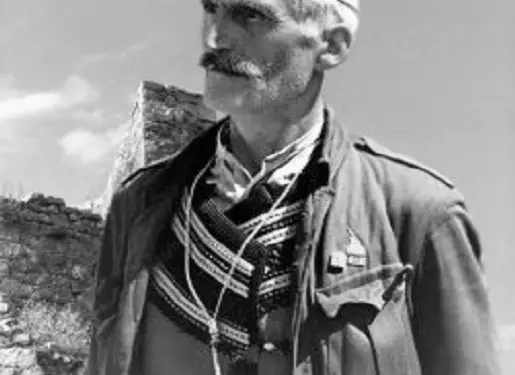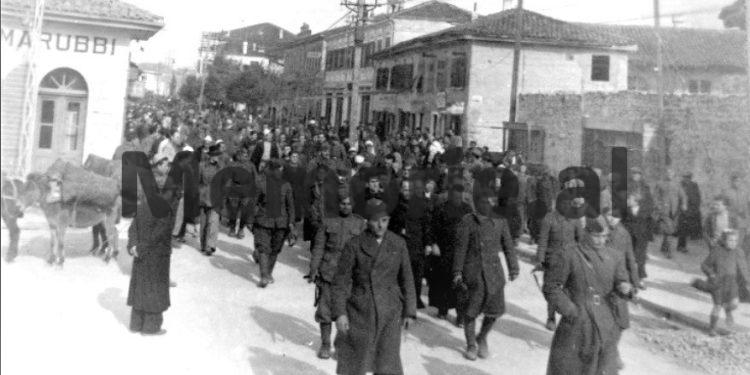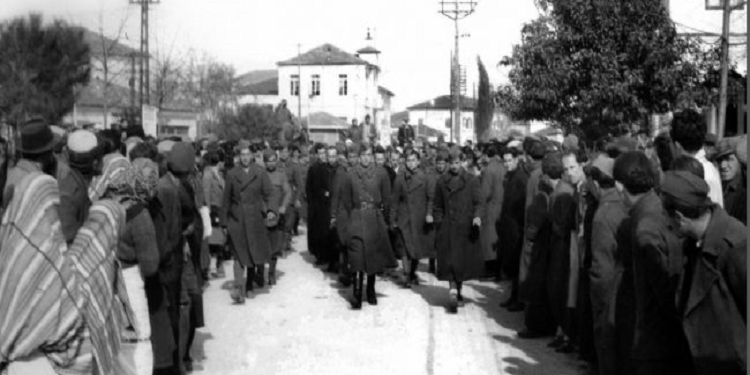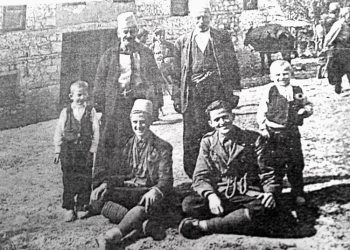By Gjovalin Gjeloshi
– “In the Kelmendi war, other nationalists from Trieshi, Gusia, etc., as well as some Serbo-Bosnian Chetniks, who had fled to escape Tito’s revenge, became active” –
Memorie.al / That winter was different, colder than others, icy, endless snow. Above the mountain, the glimpse of Kelmendi’s sky was not seen for many days. The clouds were cloudy, cold. They had that dusty gray color of a post war. In this state they hovered over the horses’ heads and shoulders. They said that the war had stopped and the country had been liberated, but those clouds started a war. Even the clouds seemed to be playing the snow rite. When the first snow that falls doesn’t melt, they say it waits for the next one. Even the brown clouds, almost the color of a military hood, did not go away. Apparently, they were expecting another war. The Kelmendas knew the clouds, especially those that heralded war. They had been used to them for 5-6 centuries. They saw special marks in the clouds, just like the marks on the shoulder of a ram or the piercing of a chicken. They foresaw what awaited Kelmendi, their invincible fortress…!
Winter captive
From Shkodër locja, from their beloved city, news was coming that you better not listen to, or don’t trust my ears. The whole of December 1944 had turned into a day of mourning in all the streets and houses of Shkodra. The castle of Shkodra knew the blackest ruler of the last five centuries. Their Shkodra brothers, friends, acquaintances and even their spiritual leaders, the Catholic Clergy, were spending their days in agony.
The Albanian communists, brothers of their centuries-old enemies, the Serbo-Montenegros, were treating their headquarters worse than the Turkish Pashalars. Many houses, even religious buildings, had turned into torture chambers. Civilian killings had begun.
What was going on?! The conqueror had passed Hani e Hoti for days. Innocent Shkodra was being treated by the Albanian communists, worse than Berlin a few months later, by the allied armies, where the last Nazis surrendered. Terror, screams, cries, arrests, imprisonment, murder and hanging, inhumane torture, death in prisons, boots and oppression worse than the Germans. The butchery, never like that of the Montenegrins when they stormed over the dreamed Shkodra, was more bloody. He spits mud against the churches, without comparing it to that of the Turks. The first shootings of their brothers, the Kelmendas from sub-Shkodra, in Malin e Koljave, in Trush, in Breg te Mata, etc.
Were all these not enough to encourage the self-defense instinct of the Kelmendas up there in the “red mountains”? Unfortunately, what was said about communism was not just words or slanderous propaganda. They had ungratefully put the “tribojnica” of the Yugoslavs, next to the flag with the flag, on the companje of the Great Church. In the memory of the Kelmendas, many difficult winters had passed, winters of war and suffering, but no one was captured. This was the first winter that they really didn’t want war, but they didn’t want captivity either, they didn’t want forced friendship with the skjau either. They could not be touched in their free spirit.
January 13 – February 26, 1945
In so many days, this war imposed and not at all desired by the Kelmendas began and ended. This war, until 1990, written only in the memory of those who barely survived and in the state archives, is the first anti-communist war, not only in Albania. This war, which was also the first failure after the escape of the last Nazi from Hani Hoti, was never mentioned…!
They taught Kelmendi. That brave people, who never “hurried nor endured anyone”, had to be taught a lesson, the dignity of the mountaineer had to be lowered, which preserved the chastity of the soul and the purity of the mountains. “Kelmendasi,” writes Father Zef Pllumi, “is the prototype of that Albanian, who does not want to submit to anyone”. Those permanent freedom fighters were called in the slang of communist words; “the last remnants of the North’s reaction”. Towards Kelmendi, the training of the first battalions began, which actually did not constitute the first military training.
400 years ago, Arslan Pasha of Podgorica taught, but this time it was not him. It was neither Ibrahim Aga, who declared war on Kelmendi in 1617, nor Mehmet Bey of Istanbul, who took control of this castle in 1633. The Kelmendas did not have a broken heart when they fought in 1638 with Vuçi Pasha, who commanded the army of 15 thousand soldiers, but their hearts were wounded that winter of 1945, when they did not already have in front of them the most terrible pasha of the Sultan. In the composition of this army today, there were no mercenaries such as Serbs, Dalmatians, Bosnians or Bulgarians, as then, but the black fate had brought all Albanians against Albanians.
Kelmendi, this time, was not taught either by Pasha of Begollaj of Peja, who taught him in 1700, nor by Brahim Pasha of Trebinje, who declared war on him in 1739. That winter, Sulejman Pasha did not attempt to enter Kelmend with his army as in 1740, nor did Krajl Nikolla of Montenegro, in later years.
This time, the head of the army was not Mark Milani, who sent 12,000 soldiers to occupy Kelmendi, but Mehmet Shehu, the known bloodthirsty, affected by the anti-nationalist, anti-Catholic, anti-northern “syndrome”. against everything dearly preserved until then with fanaticism, in our mountains and pro-Slavic and communist.
The first rifle
History says that the First World War was caused by a murder. A Serb killed the Austro-Hungarian prince, Franz Ferdinand, who was visiting Sarajevo at the time. The bloody ten-year war of ancient Troy was caused by a female robbery: Helen. Are you saying that the First War would not have been caused if the Serbian student did not shoot the prince? Who knows. The start of Kelmendi’s war was caused by the killing of a partisan mountaineer: Mark Gjeloshi of Rehovica, who had just come out of the mill, with the ground load. He was hurrying to take home the children’s bread. The rifle cut him in half.
That crack was fatal. That barrage of light machine guns cut off any possibility for these Albanians to come to an agreement among themselves. Perhaps the fight was inevitable, because the communists did not make any pact with anyone, but time would do its job anyway. Maybe days would pass and men would be found in the teaching side as well, to take stock of an unnecessary fight. However, these words already sound empty. “The sword was unsheathed.” Bad coincidence. Partisans killed an innocent man. that was carrying the burden, perhaps of the last of the witch’s flour for that winter.
The Bridge of Tamar thus inevitably became the first battleground of this cruel war. The unexpected fire was poured on the partisan brigades, from the directions of Broja, Gropave te Stera, Katabuqi, etc. The valley of Cemi was ravaged by fratricidal war, but still not civil: in front of it were military brigades known for their terror, more on the civilian population than on the enemy. The water of the Cemi river lost its clarity. It was reddened with the blood of Albanians, whose communist doctrine was raising them to war against each other.
Although the balance of this battle was tragic and the 1st Battalion of the 1st Assault Brigade was in danger of being completely out of the fight, the command informed the center that; “The 1st Brigade continues to be a sound fighting force…! Their morale is high. No fatigue or dissatisfaction can be seen in them”. Whereas, the day before, mothers’ sons had been killed.
It doesn’t matter what trench time had placed them in. Even after this complete demobilization of the partisan battalion, no one from the leadership thought to analyze, take into consideration the difficulties and think differently, besides the war. No, the soldiers were painless. They were “ball fodder” in the hands of the division headquarters. As for the Kelmendas, it was understood that they were already the “enemy”.
The country is fighting, not Kelmendi
Who knows when and from whom, this expression came, but one thing is known: the “Bajlozes” who taught this country one after the other, who “went with a sword and returned without a head”, to somehow wash away the shame of losses, because the teaching armies were always several times more numerous than Kelmendi’s forces, they said: “The country is fighting there, not the Kelmendis.” In fact, they themselves knew it. that “the country and Kelmendi” were fighting.
After the first confrontation of the partisan forces with the Kelmendas, other attempts to cross the Tamara Bridge suffered the same fate. The only eyewitness to all that bloodshed is Cemi. Any attempt to cross that raging, icy river was met with an unimaginable combative response by government forces. Those days, every shot and every shot of Kelmendi turned into a trench for these indomitable petrits and every stone became a bullet for the opponents. The frontal war, although with very unequal forces between the sides, became devastating for the partisan battalions. In addition to the unparalleled endurance with weapons, Kelmendi also came to the aid of the harsh winter.
The partisans panicked. Most of them no longer thought about the war, but thought about shelter and saving their heads. They dispersed into that unknown terrain wherever they could, like a leaderless mob. In this war, from the local side, there were no “reactionary scum”, as the red propaganda wanted to call them, but almost everyone who could fight. It was Kelmendi, with men and women. It was all Vukli and Nikçi, this time, not “male for spi”, but “sppi for sppi”, although a little more withdrawn; it was Selca, with its most prominent heroes. In this bloody epic, women warriors were not missing, who also gave their lives.
Pashka Elezja and Katrína Nikja, women from Nikçi, who sacrificed themselves when they fell into the hands of the partisans, who were asked to lead them to paths they did not know. It was impossible for the partisan brigades to progress in the directions they had set themselves the objectives. The morale of the partisan forces, surrounded by the cold, the unknown snow and sleet, had known the end.
Only three people in Pshtan, Gjon Sokoli and Zef Nik Marku of Nikçi, as well as Ujk Mash Leka of Selce, kept a battalion of partisan forces pinned down for 12 hours. They crossed the neck, only on their slain bodies. Everywhere in Broja, Qafë t Cjapi and, everywhere in the Cemi valley, the military forces encountered the incomparable resistance of the mountaineers and were forced to return to the base of departure.
It will always remain in the history of the highlands, the act of three women from Selca: Mri Lucja, Mri Mirukja and Make Docja, who “captured” a squad of partisans, who, although armed, were out of combat, due to the conditions of difficult weather. Except they did nothing else, but cut them and took them to their homes, to bring them to life. Frozen bodies were found here and there. In two weeks and more of frontal war, the forces, now of the “provisional government”, that had attacked Kelmendi, had already gone to non-existence.
The real situation could no longer be hidden and the headquarters of the second division could no longer report to Tirana; “for the excellent condition of our forces, under the command of Kelmendi”. Kelmendi could not submit with 2-3 battalions and Mehmet Shehu could no longer lead the operation from Shkodra, where he had been stationed since the day he assumed the task of commander of the operation against Kelmendi.
Kelmendi’s position was seriously endangering the newly established power of the communists, which, even without the consequences of this war, was on the brink. The manly resistance of the Kelmendas was giving hope to the anti-communist forces throughout Northern Albania, but also to the anti-communist forces operating abroad.
The temporary government of the communists had not yet been recognized and this war, at least its extension, would cost a lot to the legitimacy of the victory of the communists, who had washed this victory more with the blood of the Albanians than with the blood of the invading soldiers, all the more that Kelmendi was not unknown in the chancelleries of Europe and the fame of their just war for centuries, had crossed the borders of the region. Other nationalists from Trieshi, Gusia, etc., as well as some Serbo-Bosnian Chetniks, who had fled to escape Tito’s revenge, also became active in the Kelmendi war.
In Kelmend, the saw was stuck in the nail, other plans are made for general lessons and combat actions are undertaken on a much larger scale than up to these moments. Mehmet Shehu approaches Kelmendi, deploying to Rapsh i Hoti, to follow the fighting more closely. Of the 24 brigades that the National Liberation Army had, in the fall of 1944, four of them received orders to attack Kelmendi. Although on the other hand it was only a matter of a battalion of forces, the commander of the operation avoided a frontal war. Cunning was needed, otherwise the accomplishment of this task was difficult.
Kelmendi was already attacked from three different directions. From Tuzi in Montenegro, no one from the highlanders expected him from there, because from that side, he had only come to them. Other battalions would take the road from Shkreli, via Boga and cross the Alps and the third direction was again Rapsha and Grabomi, from where all the first measurements were made. Thus, Kelmendi was surrounded and bathed in blood.
Medieval punishments
It’s the war. It is also after the war. Each has its own laws. You can be a soldier in war and you have killed, because yes don’t kill you will be killed, but you can be a captive or just an unarmed civilian after the conflict is over. With the exception of one case, where a battalion commander was taken prisoner and after an impromptu trial, without the knowledge of the leader of the Kelmendas, Prêk Cali, was shot, the highlanders treated the prisoners with dignity, which were not few during this war. .
There are many cases where the tired and demoralized partisans, captured by the mountaineers, brought them into the house, clothed them, warmed them and held them, and after filling their bags with food, they were allowed to go there from they wished, and even passed them on.
The bodies of the partisans found frozen in the snow were buried with respect and honors. Sons of mothers, Albanians. But this respect would be overturned by the partisan forces, led by people with cannibalistic instincts, as soon as the Kelmendas were defeated. In these commemorative lines, I will not write names that fell in frontal or guerrilla warfare, because anyway, they were killed with weapons in hand.
If I wrote the names of mountaineers, the names of the partisans should also be listed. Those who fought with each other in this case were not enemies, only opposite thoughts, for the time that was coming, had thrown them in different directions.
The punishments that were carried out in retaliation for the rebellion of the Kelmendas were medieval. By the dozens, guilty or innocent, they were massacred, burned alive in towers, cut at the throats like cattle, covered with stones and earth for life, thrown from broken rocks, strangled with spikes and then shot with dead rifles, were shot in front of family members, children and grandmothers.
Grandpa Gjon Bajraktar of Vukli was burned alive in his own home, after being torn from his mother’s breast and from the caresses of small children. For a week straight, there was the smell of the meat that the cannibals had roasted. In the tower of Fran Zef Nikçi, the brave man from Trieshi, Lukë Tomë Trieshi, who lived in Gusi, but had responded to Kelmendi’s call for war, was also burned. They do the same with Zhuke Toma.
Luc Gjon Bajraktar, together with the voivode of Vukli, Luc Gjon Rapuka, is shot in Buca, just as three brothers were shot at the same time in Broja: Marash, Ujk and Ndue Mark Bikun. Four more brothers who were shot: Pal, Lekë, Mark and Lulash Vuksani, they also lived in Gusi. Nika, the son of Luc Gjon Bajraktar, is cut in the neck, at the grave of commander Fejzi Micoli.
They do the same with Losh Fran Alina. Even Serbo-Bosnian Pero Kolashini has his throat cut with a knife. They massacre Fran Zef Bajraktar, gouging out his eyes and stone him for life. As for Shyta Tomë Lucës, they behead him alive and cover him with earth.
Mark Tomë Lucë and his father, Tomë Luc Prelë, were strangled until their souls passed out. Idriz Kadri Muçë, after being strangled, was shot dead with a rifle, and Dede Gjon Dede e Gusië, strangled in Koplik, torturing him. Lazar Dede Shyti was shot in Godi, at the end of Vermoshi. Lul Mirash Ujka, (Preldakaj), was shot in Ravinos, Nikçi district.
Jjon Locin, was shot in the backyard of his house; Fran Gjokë Lula, allegedly being brought to Koplik for trial, was killed in Leqe i Hoti; Marash Vata of Vermoshi was shot in the church of this village and Nikë Lulash Smajli was shot in Gërçar.
Nik Mark Ujka was shot on the same day as Dom Lek Sirdani. Rrok Zef Gjon Rapuka, the grandson of the voivode, was thrown to pieces in She te Noriu and Rrok Gjon Rapuka was thrown from the cliff in the place called Spella e Dhelpna. Not even Mria e Tomë Dosh Preka was spared, who was shot together with her brother-in-law, Fran Dosh Preka.
The legend was believed
Maç Luca, was the youngest of those who, at the end of the war, were locked to death in the cave, together with Prêk Calin. Today he is the oldest and therefore the only one left alive, a man over 80 years old, but not at all tired of the sufferings and horrors he has gone through. When he shows his voice, he has it full, except sometimes, he can’t suppress his longing. Tears pooled under his chin.
“They killed us in faith,” he says, “in faith in God and the brother.” Prek Cali didn’t give up, but neither did we who stayed with him. I don’t even know today what role Father David Pici had in the bailout of our faith, but I know that he was one of the only priests who was not convicted or shot. I did it by accident. Prêk Calin in the cave, I remember him sitting on a stool. He was constantly smoking. He was a tired old mammoth. I remember that he kept asking: Bac, how many days do you want my date to come…’! It seems that he was waiting for a date, a day”, – concludes the living monument, Maç Luca.
Maybe a promise that; “if you stay and fight the Kelmendas, we will help them and intervene”, he was waiting for that day that never came. “Never” is, even when it comes late. They say 45 years.
The shootings of Prêk Cal, Dede Lulash Smajli, etc., and of the real soldiers of Kelmendi, Gjek Marash Preka (Selca) and Gjergj Lul Toma, put an end to this hatred that they had never seen the mountains of Kelmendi even when they tried to enter there foreign invading armies.
“Tell the highlanders of Kelmendi not to eat fish from the Cemi river for a while, because they have been fed with the flesh of their fathers’ corpses, which I have thrown from the rocks into this river”, – the cannibal would growl. Mehmet Shehu, at the end of the operation. This is how this unprecedented mynxyra was closed to open the 45-year history of suffering. Kelmendi would pay the tribute of non-submission.
Late, a Kelmendas, who was my grandfather, on his deathbed, at the end of 1981, when he was shown the news on the radio that Mehmet Shehu had killed himself, barely moving his lips, he spoke these words: “He has killed the people’s sin, – he said, – he did not kill himself”! Memorie.al
















